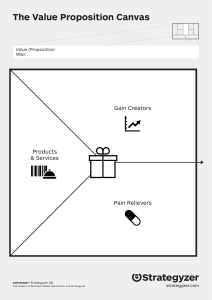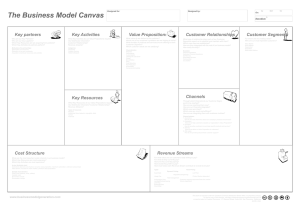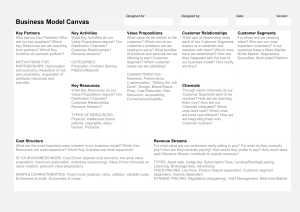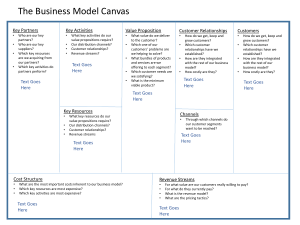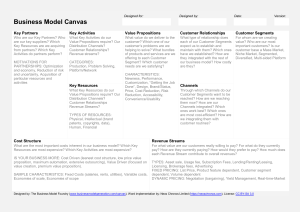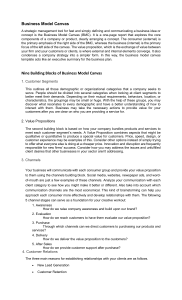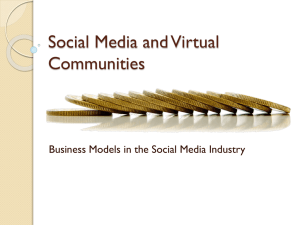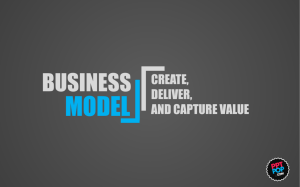Phase 3: Launch Social Business Model Canvas
advertisement
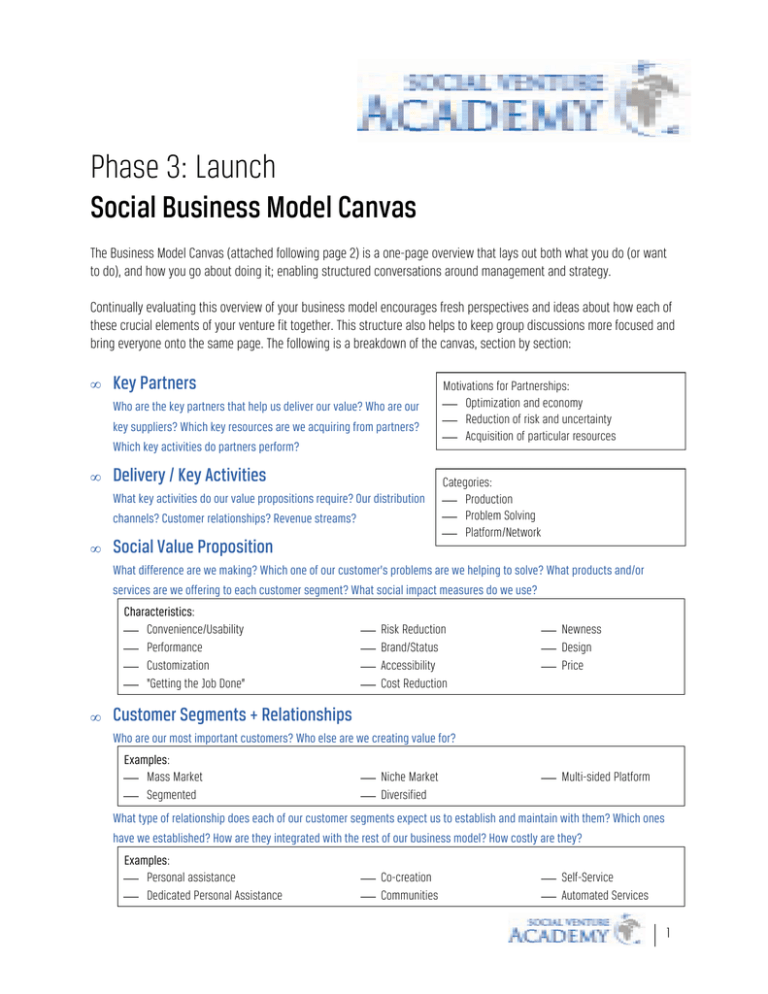
Phase 3: Launch Social Business Model Canvas The Business Model Canvas (attached following page 2) is a one-page overview that lays out both what you do (or want to do), and how you go about doing it; enabling structured conversations around management and strategy. Continually evaluating this overview of your business model encourages fresh perspectives and ideas about how each of these crucial elements of your venture fit together. This structure also helps to keep group discussions more focused and bring everyone onto the same page. The following is a breakdown of the canvas, section by section: • Key Partners Who are the key partners that help us deliver our value? Who are our key suppliers? Which key resources are we acquiring from partners? Which key activities do partners perform? • Delivery / Key Activities What key activities do our value propositions require? Our distribution channels? Customer relationships? Revenue streams? • Social Value Proposition Motivations for Partnerships: ! Optimization and economy ! Reduction of risk and uncertainty ! Acquisition of particular resources Categories: ! Production ! Problem Solving ! Platform/Network What difference are we making? Which one of our customer’s problems are we helping to solve? What products and/or services are we offering to each customer segment? What social impact measures do we use? Characteristics: ! Convenience/Usability ! Performance ! Customization ! “Getting the Job Done” • ! ! ! ! Risk Reduction Brand/Status Accessibility Cost Reduction ! Newness ! Design ! Price Customer Segments + Relationships Who are our most important customers? Who else are we creating value for? Examples: ! Mass Market ! Segmented ! Niche Market ! Diversified ! Multi-sided Platform What type of relationship does each of our customer segments expect us to establish and maintain with them? Which ones have we established? How are they integrated with the rest of our business model? How costly are they? Examples: ! Personal assistance ! Dedicated Personal Assistance ! ! Co-creation ! Communities ! Self-Service ! Automated Services 1 • Macro Economic Environment What changes are currently taking place that affect your market? What trends have you researched? What is the future of your market? Can you foresee any additional changes? Examples: ! Social variables ! Technological innovations • ! Economic growth/decline ! Change in market accessibility Competitors / Differentiation Who else plays in our space and what makes us different? What key resources make our value propositions unique? Our distribution channels? Customer relationships? Revenue streams? Types Of Resources: ! Physical ! Human • ! Intellectual (brand patents, copyrights, data) ! Financial Sales + Marketing Channels Through which channels do our customer segments want to be reached? How are we reaching them now? How are our channels integrated? Which ones are most cost-efficient? How are we integrating them with customer routines? Channel Phases: 1. Awareness ! How do we raise awareness about our products and services? 2. Evaluation ! How do we help customers evaluate our value proposition? 3. Purchase ! How do we allow customers to purchase specific products/services? 4. Delivery ! How do we deliver a Value Proposition to customers? 5. After sales ! How do we provide post-purchase customer support? • Cost of Delivery / Cost Structure What are the most important costs inherent in our business model? Which key resources/activities are most expensive? Is Your Business More… ! Cost Driven (leanest cost structure, low price value proposition, maximum automation, extensive outsourcing)? ! Value Driven (focused on value creation, premium value proposition)? Sample Characteristics: ! Fixed Costs (salaries, rents, utilities) ! Variable costs Economies of scale ! ! Economies of scope • Revenue Streams For what value are our customers really willing to pay? For what do they currently pay? How are they currently paying? How would they prefer to pay? How much does each revenue stream contribute to overall revenues? Types: ! Asset sale ! Usage fee ! Lending/renting/leasing ! Licensing ! Brokerage fees ! Advertising ! Fixed Pricing: ! List price ! Product feature dependent ! Customer segment dependent ! Volume dependent Dynamic Pricing: ! Negotiation ! Yield management ! Real-time-market 2 3 ! Introducing the Business Model Canvas, a tool for visionaries, game changers, and challengers. This method from the bestselling management book Business Model Generation is applied in leading organizations and start-ups worldwide. Utilize this diagram to evaluate your social business model and foster discussion, creativity, and analysis. Checkout this expert rundown of the canvas from Strategyzer at https://youtu.be/QoAOzMTLP5s
